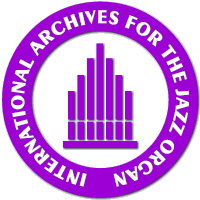
The Jazz Organ Scene
USA


|
George Russell
George (* 1923 in Cincinnati) began playing drums with the Boy Scout Drum and Bugle
Corps and eventually received a scholarship to Wilberforce University. But his most
valuable musical education came in 1941, when he was diagnosed with tuberculosis,
spending 6 months in the hospital where he was taught the fundamentals of harmony
from a fellow patient. From the hospital he sold his first work, "New World," to Benny
Carter. He joined Benny Carter's Band, but was replaced by Max Roach; after Russell
heard Roach, he decided to give up drumming, but to study the piano ionstead.
He moved to New York where he was part of a group of musicians who gathered in the basement apartment of Gil Evans. The circle included Miles Davis, Gerry Mulligan, Max Roach, Johnny Carisi and on occasion, Charlie Parker. He was commissioned to write a piece for Dizzy Gillespie's orchestra; the result was the seminal "Cubano Be/Cubano Bop" the first fusion of Afro-Cuban rhythms with jazz, premiered at Carnegie Hall in 1947 and featuring Chano Pozo. Two years later his "Bird in Igor's Yard" was recorded by Buddy DeFranco, a piece notable for its fusion of elements from Charlie Parker and Stravinsky. In the mid-fifties, a superb sextet, including Bill Evans and Art Farmer recorded under his direction, producing "The Jazz Workshop," an album of astonishing originality; the often dense textures and rhythms anticipated the jazz-rock movement of the 1970's. He was one of a group to be commissioned to write for the first annual Brandeis Jazz Festival in 1957. From 1960, Russell began leading his own sextets around the New York area and at festivals; he also toured throughout the Midwest and Europe with his sextet. Disillusioned by his lack of recognition and the meager work opportunities in America, he arrived in a wheel chair in Scandinavia in 1964. In 1969, he returned to the USA to teach at the newly created Jazz Department at the New England Conservatory. He continued to develop the Lydian Concept and toured with his own groups. He played Carnegie Hall, the Village Vanguard, the Bottom Line, Newport, Wolftrap, The Smithsonian, Sweet Basil, the West Coast, the Southwest, and Europe with his 14 member orchestra. He continued to compose extended works which defined jazz composition. His 1985 recording, "The African Game, "one of the first in the revived Blue Note label, received 2 Grammy nominations. Russell has taught throughout the world, and has been guest conductor for Swedish, Finnish, Norwegian, Danish, German and Italian radio. In 1986, he was invited by the Contemporary Music Network of the British Council to tour with an orchestra of American and British musicians. Russell has received the MacArthur Foundation Fellowship, the National Endowment for the Arts American Jazz Master, been elected a Foreign Member of the Royal Swedish Academy, two Guggenheim Fellowships, the Oscar du Disque de Jazz, the Guardian Award, six NEA Music Fellowships, the American Music Award, and numerous others. |
|
Othello Ballet Suite / Electronic Organ Sonata No. 1 Flying Dutchman FDS 122 Othello: recorded November 1967 in Stockholm/Sweden Organ Sonata: recorded October 1968 at Grorud Church in Oslo/Norway |
Othello: Arne Domnerus, alto sax Bernt Rosengren, tenor sax Rolf Eriksson, trumpet Jon Christensen, drums The Swedish Radio Symphony Orchestra George Russell, composer Organ Sonata: George Russell, church organ |
|
Electronic Sonata For Souls Loved By Nature Soul Note 121009-2 recorded June 1980 in Milano/Italy |
George Russell, piano, organ Robert Moore, soprano sax, tenor sax Lew Soloff, trumpet Victor Comer, guitar J.F. Jenny Clark, bass Keith Copeland, percussion |
 |
n/a |
| n/a |
|
You can watch the video on the YouTube site by clicking on the corresponding picture. For more videos search YouTube |
|

|
|
Back
If you don't see the left hand menu,
please go back to the homepage.
Back to the homepage